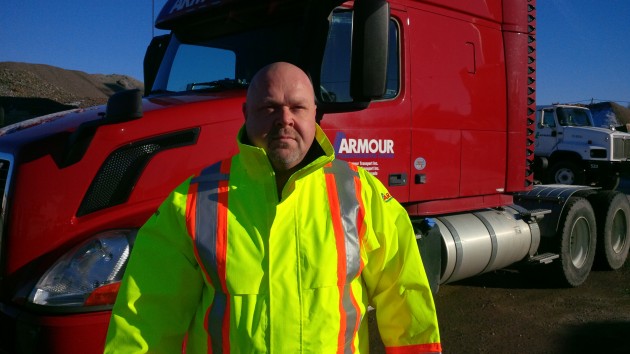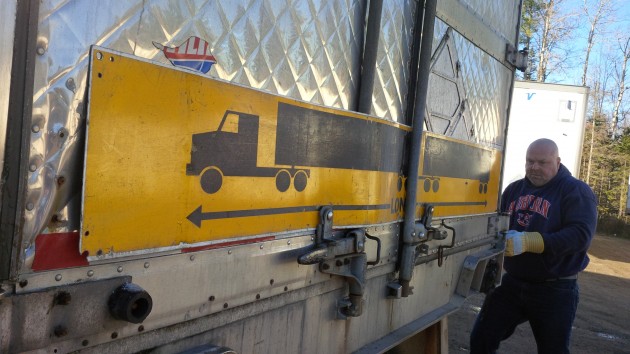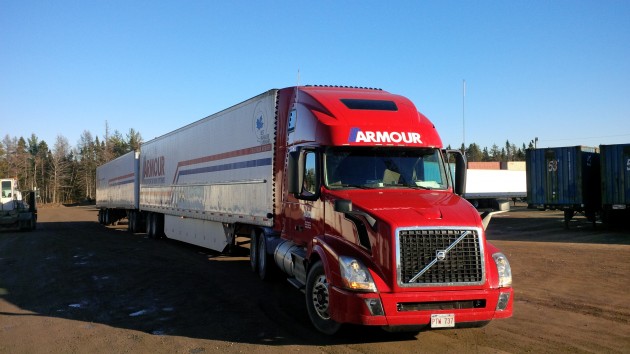LCV fleets spec’ing for versatility, fuel economy
MONCTON, N.B. — The Trans-Canada Highway from Moncton to Edmundston, N.B. is a long, plodding route with little to see and hills that will test any diesel engine’s mettle.
At night, it’s teeming with wildlife – moose, deer and even bears – which keep a driver on high alert. There’s little else to see along the way except for trees, rocky outcroppings, the meandering Saint John River…and more trees. Usually, the only excitement to this drive comes in the form of violent and unpredictable storms, which can arrive with little warning, making the trip harrowing for the ill-prepared driver. But for Dwayne Schurman, it couldn’t be more idyllic.
“I’ve been in the trucking industry since I was 18 years old looking for a job like this,” Schurman, who hauls long combination vehicles (LCVs) for Armour Transportation Systems told me as we made his regular run Nov. 25. “I landed it when I was 44 – I wish I would’ve found this job when I was 24.”

Aside from the weather, Schurman said it’s “stress-free.” He arrives to work around 2 p.m. and connects two 53-ft. trailers via a converter dolly, does his pre-trip and hits the road. He needs to be out of the city by the afternoon rush – one of the many additional rules that apply to LCV drivers. Edmundston is about 500 kms northwest of Moncton. There, Schurman meets a Rossignol Transport driver to make a switch. He drops his trailing trailer (referred to as his ‘tail’), disconnects the converter dolly, then parks the lead trailer.
He then couples to a new lead trailer (the heaviest trailer must always be at the front), reconnects the converter dolly and skillfully reverses the dolly into position to attach a new tail. All this takes less than half an hour with the help of Marty, a Rossignol driver who lives nearby and leaves the warm confines of his home to walk over to the switch yard in order to lend a hand positioning the equipment. That’s the type of inter-carrier driver camaraderie that you’ll still find in Atlantic Canada. Rossignol Transport will pull Schurman’s two dropped trailers individually across a 60-mile or so stretch of the Trans-Canada Highway in Quebec that has yet to be twinned, before re-assembling them as LCVs for the trip on to Montreal. Schurman, doubled up once again, heads back to Armour’s Moncton terminal. All in a night’s work.
“It’s a long day. A lot of guys would love to haul the LCVs, but this run is 600 miles a day and that’s hard on any trucker, let alone an LCV driver that’s doing 90 km/h (another of the rules that applies only to LCVs),” Schurman explains. “But in the truck, I’m thinking of how fortunate I am to be doing what I’m doing and to have the freedom to do what I’m doing – sitting behind the wheel rather than sitting behind a desk with some boss bitching at me all day. I feel like I’m my own boss. I feel like I have the freedom a lot of people don’t have and I have a lot of responsibility, but also the freedom to go with it.”
Schurman makes this run four nights as week. When he agreed to the job, he did so thinking it would take him to his retirement – as long as he didn’t burn out.
“I said I want to do this for 20 years, I don’t want to burn out,” he tells me, which is why he makes the run four nights as week and not five. He sleeps in the truck at Armour’s yard on driving days and enjoys three days off every week, which allows him to pursue his other passion – golf. He golfed 100 rounds this summer.
“Weather permitting, I golf two rounds a day,” he says.

You get to know a guy pretty well when you spend 12 hours in the truck together. The purpose of my visit to Atlantic Canada was to report on a reasonably new powertrain combination that’s gaining a following in Canada – you could even call it a made-for-Canada spec’. It brings together Eaton’s 16-speed UltraShift Plus LSE automated manual transmission – the only 16-speed in the market – and the Cummins ISX15 engine. I’ve driven this combination in a Challenger truck grossing about 80,000 lbs but never in an LCV application (I’m not LCV-certified) or hauling heavy payloads. The LSE/ISX combo was initially exclusive to Navistar but it has since been rolled out to other OEMs and is now widely available.
This powetrain was under the hood of a Volvo VN670, and the powertrain package was rounded out with Meritor MT40-14X axles with 2.85 ratio. There’s some downspeeding at play here, but not to the same extent as the linehaul SmartAdvantage spec’, which capped at a GVWR of 80,000 lbs, is too limiting for most Canadian haulers. The LSE/ISX15 combination can be safely used to haul loads grossing up to 110,000 lbs, making it versatile enough to pull regular LTL or truckload freight as well as LCV loads.
It’s designed to produce good fuel efficiency at a broader range of gross vehicle weights, which is ideal for Schurman, who often hauls an empty tail to Edmundston but two loaded trailers back, averaging about 110,000 lbs inbound and about 90,000 lbs out. While there’s more freight entering the Atlantic region than leaving it, Armour still has to balance its trailer pool, which is why Schurman often hauls an empty tail west and is why a versatile powetrain spec’ is required.
“The 16-speed is designed for 110,000 lbs. It covers that niche we have in Canada,” explained Peter Messeroll, who handles large fleet accounts in Canada for Eaton. “Fleets don’t want two different spec’s – one for 80,000 lbs and another one to do 110,000 lbs. The 16-speed covers the 110,000-lb segment.”
One of the trickier aspects to spec’ing this powertrain, Cummins rep Adam Whitney explains, is dialing it in for optimum fuel economy at both 90 km/h, for when hauling double-53s, and at 100 km/h, for when pulling single trailers.
The transmission boasts small steps through the entire range of gears, providing quick, precise shifting. It has been well integrated with the ISX15 to remain in the engine’s sweet spot as much as possible – when driven properly, that is.
Wes Armour, CEO of Armour Transport, said some driver training is required when switching from manual transmissions to automated manuals. This engine lugs down on the hills more than drivers were accustomed to.
“LCVs haul hard,” Armour said. “You can put the same weight on a tri-axle trailer and does it ever haul a lot easier than that second trailer behind; it’s just a dead pull. I figured, we’ve gotta give the drivers something to work with here.”
Some drivers were initially put off because they were moving from engines rated at 450 hp to Cummins’ new 475-hp rating and so they expected to be able to charge up the hills. But the powertrain wasn’t spec’d that way, even if it had sufficient power to do so.
“I think the perception of what they were getting was something different or better, or more torque in the hills, but it’s not designed that way, it’s designed for fuel economy,” Messeroll explains. “If you’re hauling heavy, it’s going to run like such.”
Whitney said peak torque on this ISX occurs at 1,000 rpm, down from about 1,200 rpm traditionally, so the engine does lug down more than in the past. This ISX15 was rated at 475 hp and 1,650 lb.-ft. of torque. It was equipped with Cummins’ new ADEPT package, including SmartCoast and SmartTorque 2.
SmartCoast disengages the transmission while keeping the clutch closed on downhill grades of less than 4% to save fuel. When the truck exceeds the set cruise speed by more than 3 mph, the engine brake kicks in to control the speed. Our drive was well suited for SmartCoast and it did its thing frequently, at times dropping to idle for 10 seconds or more as we descended longer grades. Schurman is still getting used to this feature and had to fight the urge to tap the brakes to re-engage the transmission.
“It’s not a big thing, it’s just something I’ll have to get used to,” he told me. “But I find I’m on the brakes now more because of that.”
The speed at which the transmission will re-engage with the engine is programmable. You can let it exceed the set cruise speed by as much as 6 mph, but the truck cops here keep a close eye on LCV traffic and don’t take kindly to violations.
SmartTorque 2 interacts with the grade sensor on the transmission to determine exactly how much torque is required given the current road profile, calculating the torque required based on road grade and GVW.
“If we know we’re not on a significant grade, we can decrease the torque available at that given time without taking it away from the driver when he needs it,” Whitney explains. “It’s seamless to the driver. It’s going to give maximum torque when the engine estimates there’s about a 76,000-lb GVW. For an LCV application, we’re really not going to take away any of that torque but when you’re light on the way out and heavy on the way back, we may dial it down to 1,550 or 1,450 lb.-ft.”
Whitney said in a typical linehaul application averaging 80,000 lbs, SmartTorque 2 can reduce fuel consumption by about 1-2%.
Three trucks spec’d with the 16-speed Eaton UltraShift Plus LSE and Cummins ISX15 engine were deployed into Armour’s LCV fleet in June. So far, Armour is pleased with the results versus the 10-speed manuals drivers were previously operating.
“We’re finding we’re getting better fuel mileage than I ever thought we’d get with LCVs,” Armour said. “We’re seeing fuel mileage in that 6 mpg range, some a little over 6 mpg. To me, that’s very good when you’re hauling the weights we’re hauling with the drag of that back trailer.”
Eaton’s Messeroll is quick to point out the 16-speed isn’t for everybody. With weights beyond 110,000 lbs he suggests going with a 13-speed transmission and slower rear axle ratio.
•
Back in the truck, Schurman talks about why he enjoys pulling double-53s and why he especially loves doing so for Armour.
“They’re fair to their employees,” he says. “The pay is comparable to any other company, but they just treat their employees well. You look around Armour and there’s so many people who’ve been there 25, 30 years – drivers, in the office, dispatch – I’ve known all these guys for 25 years from when I first started coming here.”
Schurman drove for Armour for a spell early in his career and then left – on good terms – to pursue other interests and opportunities, including a sojourn to Alberta. He returned when Armour got into the LCV business and he was offered the opportunity – on the golf course, no less – to rejoin Armour and take on a dedicated LCV run.
Schurman said he’s paid a flat rate per trip and extra for coupling and uncoupling, so his income and schedule are predictable. Having nice equipment to run doesn’t hurt either.
“They run good, top of the line equipment,” he said. “I’ve been here three years (running LCVs) and this is my second brand new truck in three years. They like to have newer trucks on this run because of the long distance.”
He said they also usually save his truck for him on off-days, which is a nice bonus.
As for the added challenge of pulling two 53-ft. trailers, Schurman said it’s something you get used to.
“You’ve always got to be paying attention and know what’s ahead of you and beside you and what’s coming past you – especially when it gets raining and windy,” he says. “Some people will try to pass you and they don’t see the second trailer till they’re halfway out, then they don’t know what to do. I’ll back off a little bit and let them get around me. I think that’s the purpose of our speed limit of 90 km/h; it’s not necessarily because of our ability, it’s because of the traffic that has to get around us. I think if you’re aware of what’s around you, what’s going on, you can almost tell what a driver’s going to do before they even do it.”
While the prospect of pulling Twin-53s over the hilly terrain of northwestern New Brunswick may seem daunting to many drivers, Schurman said he finds it “relaxing and peaceful.”
“It’s a stress-free job,” he said. “The only stress I have in this job is the weather. I call the other driver (arriving in Edmunston) and they let me know what it’s doing up there. I make the decision (whether to pull one trailer or two) and if I tell (Armour) I’m only taking one trailer, they don’t question it. It’s my decision and they respect that.”
The powertrain spec’s
Tractor: Volvo VN670
Engine: Cummins ISX15 475 hp/1,650 lb.-ft.
Transmission: Eaton UltraShift Plus LSE (16-speed)
Tandem axles: Meritor MT40-14X, 2.85 ratio

Have your say
This is a moderated forum. Comments will no longer be published unless they are accompanied by a first and last name and a verifiable email address. (Today's Trucking will not publish or share the email address.) Profane language and content deemed to be libelous, racist, or threatening in nature will not be published under any circumstances.